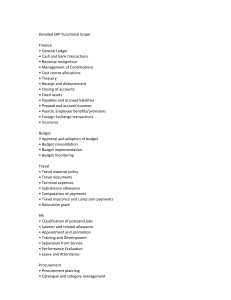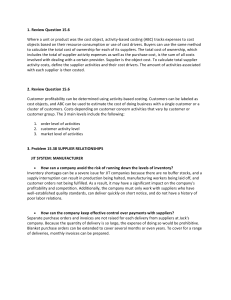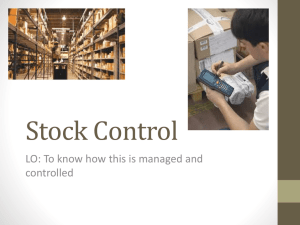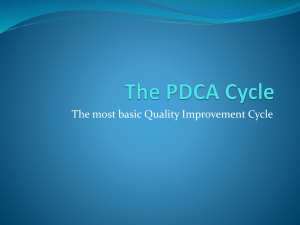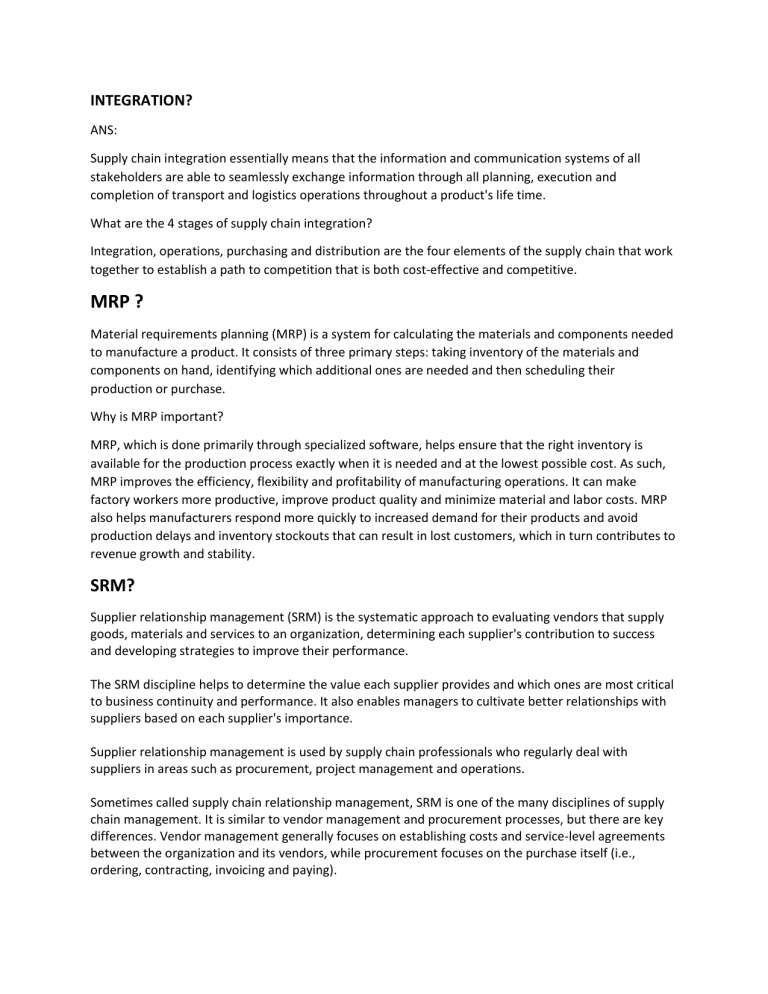
INTEGRATION? ANS: Supply chain integration essentially means that the information and communication systems of all stakeholders are able to seamlessly exchange information through all planning, execution and completion of transport and logistics operations throughout a product's life time. What are the 4 stages of supply chain integration? Integration, operations, purchasing and distribution are the four elements of the supply chain that work together to establish a path to competition that is both cost-effective and competitive. MRP ? Material requirements planning (MRP) is a system for calculating the materials and components needed to manufacture a product. It consists of three primary steps: taking inventory of the materials and components on hand, identifying which additional ones are needed and then scheduling their production or purchase. Why is MRP important? MRP, which is done primarily through specialized software, helps ensure that the right inventory is available for the production process exactly when it is needed and at the lowest possible cost. As such, MRP improves the efficiency, flexibility and profitability of manufacturing operations. It can make factory workers more productive, improve product quality and minimize material and labor costs. MRP also helps manufacturers respond more quickly to increased demand for their products and avoid production delays and inventory stockouts that can result in lost customers, which in turn contributes to revenue growth and stability. SRM? Supplier relationship management (SRM) is the systematic approach to evaluating vendors that supply goods, materials and services to an organization, determining each supplier's contribution to success and developing strategies to improve their performance. The SRM discipline helps to determine the value each supplier provides and which ones are most critical to business continuity and performance. It also enables managers to cultivate better relationships with suppliers based on each supplier's importance. Supplier relationship management is used by supply chain professionals who regularly deal with suppliers in areas such as procurement, project management and operations. Sometimes called supply chain relationship management, SRM is one of the many disciplines of supply chain management. It is similar to vendor management and procurement processes, but there are key differences. Vendor management generally focuses on establishing costs and service-level agreements between the organization and its vendors, while procurement focuses on the purchase itself (i.e., ordering, contracting, invoicing and paying). JIT? There are a lot of benefits that come with the “just in time” methodology if you can implement it correctly. It’s not the simplest to execute, though, and it’s not worth jumping into without knowing the facts. So in this blog post, we’ll take you through the specifics of what a JIT system is and how it works, so you can determine if it is the next best decision you make for your company. Still not sure if JIT is the best fit for your operations after you read through this blog post? Reach out to us and let us help you find the next best platform to manage your manufacturing and inventory! What is JIT? Just in time (JIT) is a manufacturing and inventory system that helps to increase efficiency and decrease loss. This supply chain management strategy aims to align raw material deliverers directly with the production schedule and customer orders. This essentially ensures that materials are shipped “just in time” for when the factory is ready to produce the goods, and the goods are produced “just in time” to be shipped out to customers or distribution centers. JIT moves materials to the right location at the right time, just before it’s needed. This increases efficiency by minimizing the space required to “hold” materials before they’re actually needed. It also decreases waste and loss by receiving the correct amount of goods for the production process. JIT keeps the process running smoothly and streamlined without a lot of extra stuff hanging around. PROCUREMENT: CENTRALIZATION: Centralization refers to the process in which activities involving planning and decisionmaking within an organization are concentrated to a specific leader or location. In a centralized organization, the decision-making powers are retained in the head office, and all other offices receive commands from the main office. The executives and specialists who make critical decisions are based in the head office. DECENTRALIZATION: ERP: CO SOURCING: Co-sourcing is a form of outsourcing solution in which an organization accesses assistance from a specific outsourced contractor or professional. Similar to contractor hiring and consulting, you'll be able to access external support for your internal team. ISO 9000 AND 14000: What is the difference between ISO 9000 and ISO 14000? The ISO 9000 is mainly for manage quality management, quality assurance that helps companies to maintain quality standards. ISO 14000: This ISO 14000 is used for environmental health.. SUPPLIER PARTNERSHIP : Supplier Partnership: A commitment over an extended time to work together to the mutual benefit of both parties, sharing relevant information and the risks and rewards of the relationship. There are multiple benefits to developing strong supplier partnerships. These include faster supply processes, improved quality, reduced risk, better problem solving, and more rapid and widespread innovation. In addition, creating partnerships can boost loyalty between clients and suppliers. This loyalty can be beneficial in situations where resources are scarce or supplies are limited, such as the current recession, as the suppliers are more likely to prioritise current partnerships over new business. 5 KEYPOINTS OF SRM: A fine-tuned SRM strategy reduces your operational headaches by setting standardized processes for working with suppliers. These help to streamline your supply chain management processes and ensure suppliers are toeing the line and meeting their obligations.But that’s not all. Besides relationship building, other goals of SRM include: Risk management and mitigation: Being able to identify potential supplier risks as they come up will keep you one step ahead of any potential disruptions to your supply management processes. Efficiency and cost savings: When you streamline your supplier performance management, you minimize operational costs and avoid unnecessary delays. This means better profit margins and better value for your customers. Value creation: Working with providers across your value chain can help your team unearth ways to increase your competitiveness while also boosting your profitability through greater efficiency, as mentioned above. Increased supplier loyalty: A more effective relationship with your vendors can help you increase trust between you and your key suppliers. You may find that trust is rewarded with improved loyalty and commitment. Better communication and cooperation: Open communication with your key suppliers makes it easier to identify and resolve problems together before they escalate and disrupt the flow of your business operations. Building strong vendor relationships is a crucial part of your third-party risk management strategy — and effective supplier management systems are essential for helping you look after your supplier base. FRAMEWORK OF SUPPLYCHAIN DEVELOPMENT: Framework and importance of Supply Chain Management Supply chain management (SCM) is an important factor in managing the product of a business and recognizing the needs of the customer. In the supply chain, crucial information for a business is contained in order to decide how a commodity is sold in order to change prices and value for the consumers. Companies who manage their supply chains will increase their profitability and satisfy their customers' requirements better. What is supply chain management? Supply chain management (SCM) is managing the complete production flow of goods or services to improve quality, delivery, customer experience and cost-efficiency. In other words, SCM begins with designing the raw materials to distributing the final product to the customers. How does supply chain management work? ANS: The supply chain management process includes a wide variety of functions, from receiving an order till delivery of products and after-sales services. Some of SCM's core activities are as follows: Constant provision of intermediary or raw goods and services will maintain business continuity. Tracking and monitoring of goods status, business activities, etc. Identify strategic locations to achieve beneficial outcomes. Streamlining of redundancy reduction processes and operational cost reduction. Conducting a business with a market situation and overall condition relevant and competitive. Mounting, testing, packing and delivery of any production activities. The logistics are organized to deliver and distribute the products in a timely manner. After-sales support management and returns for processing. The timely delivery of high quality products will enhance customer satisfaction. Plan production and distribution through consumer demand forecasting. Efficient inventory management increases the level of unprecedented demand.
